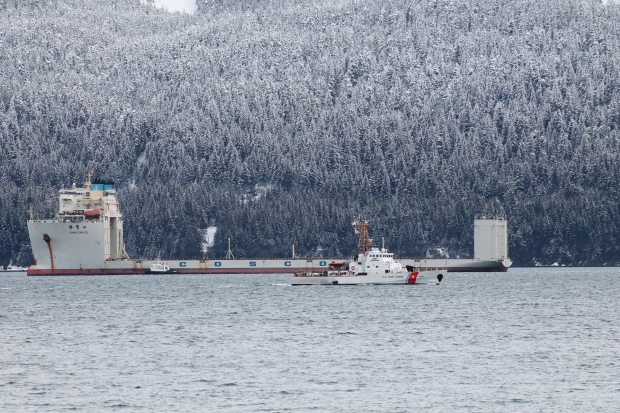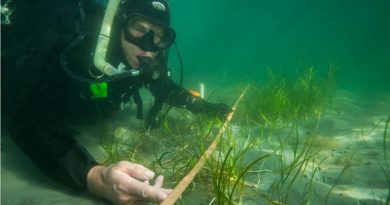Massive ship arrives in Seward, Alaska to haul troubled drilling vessel
 It’s a problem that few people probably consider: How do you ship a ship?
It’s a problem that few people probably consider: How do you ship a ship?
That’s exactly what Noble Corp, the company in charge of the troubled drillship Noble Discoverer will attempt to do in the coming days, utilizing a 708-foot, Chinese-flagged, heavy-lift ship that arrived off the Southcentral Alaska harbor town of Seward on Thursday.
The Noble Discoverer had to be towed to Seward in November after developing a problem with its propulsion system en route to port in Washington state for winter repairs and maintenance.
That followed its first season drilling in the Arctic as part of Royal Dutch Shell’s bid to find oil in the region. While in Seward, Coast Guard inspectors turned up a number of safety and maintenance issues with the vessel, issues that may even lead to legal action against Noble Corp.
Now, the 571-foot Noble Discoverer will be taken to a shipyard in Korea for repairs and upgrades after its troubled season in Alaska, a season that led Shell Oil Co. to announce Wednesday that it will suspend its 2013 drilling to assess and service its drill fleet.
And to get the drillship from point A in Alaska to point B in Korea, the immense vessel Xiang Yun Kou pulled into the waters near Seward Thursday to dry-haul the Noble Discoverer to its Asian destination.
But the Discoverer won’t be leaving right away. On Thursday morning, Coast Guard spokeswoman Ensign Victoria Swinghamer said the plan to raise the Noble Discoverer wouldn’t occur “for a few more days.”
The Coast Guard also planned to inspect the Xiang Yun Kou upon its arrival to ensure it would be prepared for its long trip across the Pacific with the Noble Discoverer atop its 583-foot-long, 141-foot-wide cargo deck. The Coast Guard cutter Mustang hovered near the Chinese ship on Thursday, along with the tug Junior.
The Xiang Yun Kou looks kind of like a quarter of a ship — it’s almost just a bow and bridge trailed by a thin tail. To load a vessel atop that long cargo platform, the ship actually sinks partway into the water — it’s dubbed a “semi-submersible” — allowing another ship or rig to be loaded on the platform before rising back up above the waves. Sinking and raising the vessel takes several hours for each action.
The ship was anchored outside of Seward instead of using any of the docks operated by the Alaska Railroad in the city. Christy Terry, Seward dock operations manager, said that the cruise ship dock has handled vessels of up to 963 feet, and vessels at the nearby coal dock can be similar in size.
First entering service in 2011, the Xiang Yun Kou also has a sister ship, the Xiang Rui Kou. That heavy lift ship will ultimately pick up Shell’s other primary drilling unit, the conical, non-mobile Kulluk from the Alaska port of Dutch Harbor. The Kulluk left Kiliuda Bay on Kodiak Island on Tuesday, after spending more than a month there awaiting assessment following a New Year’s Eve grounding.
Swinghamer said that the Coast Guard had not yet received notice of the Xiang Rui Kou’s intent to enter Alaska waters as of Thursday morning.
“I couldn’t find the vessel in our system, which doesn’t mean it’s not out there,” Swinghamer said. “…If they’re following the rules, they’re supposed to file their notice 96 hours prior to arrival (in Alaska waters).”
That means a similar operation to move the Kulluk out of Dutch Harbor is still a ways off, as the rig continues to be towed toward the Aleutians. And from there, it will join its fellow drill vessel on the way to Asia.
Whether or not the Kulluk or the Noble Discoverer will return to see action in the Alaskan Arctic again remains to be seen.
Contact Ben Anderson at ben(at)alaskadispatch.com
For more stories from Alaska Dispatch, click here



